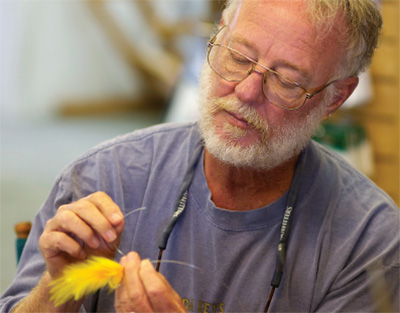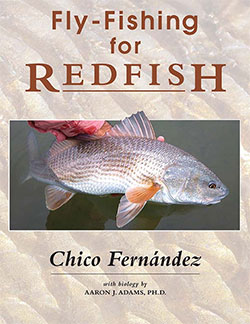Making a Redfish Leader

Top angler Sandy Moret tying a big redfish fly with a loop, for more action.
I’m going to choose a good all-around leader for redfish— a 10-foot leader for an 8-weight line with a 16-pound-test tippet—and use the popular formula of 50/30/20. You can’t go wrong with that. Just remember that while the explanation below takes some time, when you learn to make your leader, it only takes a few minutes.
First, let’s gather the tools. Get 40-, 30-, 20-, and 16- pound-test leader material. To cut materials and trim the knots, pliers or forceps with scissors will work fine, but clippers are my first choice here because they usually can trim knots much closer. To lubricate the knots before pulling them tight, get a saucer with half or a quarter of an inch of water on it, to dip the knot.
Also get a yard stick or a measuring tape to measure the sections. And if pulling hard on the sections hurts your hands, use your sun gloves or a light pair of garden gloves. I generally don’t use gloves, except when I’m tying big game leaders. Just make sure you can comfortably pull hard enough to set the knots. For those of you more advanced, a micrometer may help you, especially when using material where the manufacturer doesn’t show the diameter. But it’s not necessary. And if you’re a beginner, don’t even think about it.
Whatever material you choose, use the same make throughout the leader, so that stiffness and other properties remain constant, from the butt section to the tippet. The only exception of this rule is if you decide to use mono for the leader and carbon for the tippet or a shock tippet. About 95 percent of the leaders I make are composed of the same material, usually mono, from butt to tippet or shock tippet. For medium stiff mono materials, I like Maxima and Ande, but I’ve tried some saltwater RIO and some Umpqua that also work well. And frankly, there are many line companies making good medium stiff leader materials. These are just the ones I mostly fish. But if and when I find better, I’ll change.
We’ll start with the butt section, but first, I want you to know how I arrive at the right butt section, not just for the 8-weight line but for 5- to 10-weight lines. The ideal butt section should mimic the fly line it’s attached to, in density and to some extent, in stiffness in order to have a smooth transition of the cast’s energy, from the fly line to the butt section, and later all the way down to the fly. But leader materials are stiffer than fly lines, so what has worked out throughout the years, to match stiffness, more or less, is to use a butt diameter that is 60 to 65 percent of the diameter of the tip end of the fly line.
Since the tip end on an 8-weight line measures around 0.040 of an inch, then 60 or 66 percent of that is around 0.024 or 0.026 of an inch. And that, in most average medium stiff leaders is 40-pound-test. That is why most good saltwater anglers, either by knowledge or experimentation, now use 40-pound-test butt section on an 8-weight.
Still, the pound test is just a guide. You’re really building the butt and mid section of leaders by diameter (which really means weight), and the tippet by pound test, that is, strength. Now, let me give you an idea of the “approximate” butt section diameters that I like to use in lines from 5-weight to 10-weight. I can’t see using any lighter or any heavier outfits when fishing for reds.
Just remember to guide yourself by the diameter (which is often on the spool label these days, and that’s nice). The pound test is another guideline.
On the next page, I give you some of the companies whose materials I often use to make leaders—as a guideline to you. With the years, all of this will change—there will be other line manufacturers or distributers, perhaps better, perhaps not—but the basic principles stay the same.

And that reminds me of a story I want to share with you:
About thirty years ago, in the early 80s, I did thorough research on fly line to butt section diameter. It took me months of experimentation. But I had more time those days, probably because the Internet and cell phones weren’t around. Anyway, finally I came up with roughly the facts that I’m giving you here. So now I knew that for the 8-weight line I used for bonefish, snook, and redfish, a good butt section was something close to 0.025 of an inch or about 40-pound-test. I was proud of it. A few weeks later while fishing for bonefish in the Keys, I ran into my friend Lee Wulff at the docks. I immediately told him that I had done an exhaustive research on butt sections for bones and backcountry fishing, using 7-, 8-, and 9-weight lines. Then I waited for him to ask me what I found. But instead, Lee scratched his head slowly, while looking far into the horizon, seemingly lost in thoughts for a few seconds (Lee was an engineer), and then told me that since the 1940s, he had always thought that 0.025 inch was an ideal butt section for 7-, 8-, and 9-weight lines. He asked what I’d found.
I don’t even remembered what I answered, and I guess it doesn’t matter. But the point of the story is that basics stay the same, no matter what new leader material you get, even if it’s pink.
The chart on the next page shows the materials I often use for butt sections.
Needless to say, the principles are the same for knotless leaders, where 0.025 to 0.028 inches works well for reds. This info is generally on the package.
Now, if you bear with me a little longer, I’ll tell you another story about butt section diameters. In the early 90s, my son, Stephen, was still in high school, life was much simpler, and we both had lots of time to fish together. But when we only had half a day, we would often go fishing for snook and baby tarpon in the famous Tamiami Trail canal, on the west side of Florida, an hour and a half from Miami, where we lived. I had fished the Trail since early 1959, with Flip Pallot, John Emery, and Norman Duncan. I knew it well in those days.

The Trail canal goes east and west, so a strong northern wind will push all the water out of the north sloughs and into the main canal, and with it, all the minnows that are living in the sloughs. So it’s like nature’s natural chumming. It can be great fly fishing, with snook, tarpon, and occasionally redfish and bass all feeding against the shoreline as the minnows come out. It’s a good day for the fish, but a bad day for the minnows. The only problem is that to fly-fish in this situation, you need to cast against the northern wind and reach the other side of the canal.
Well, at this time I was late with an article assignment and didn’t have the time to rig the day before. Stephen quickly offered to rig, make sandwiches, and even drive the next morning. Anything to go fishing. Fine, I agreed and went back to my writing.
The next morning before daylight we drove to the area, well past the road that goes to Everglades City. When we got there, just at dawn, snook and baby tarpon were popping near the opposite shoreline as a strong north wind blew into us. Knowing that both of us could cast the 60 or more feet into that wind, I anticipated no problems.
We quickly took out a pair of 7-weight rods with small Muddlers that imitated the size of the mud minnows and started to cast. But to my surprise, every time I shot a loop into the other side of the canal, the fly line would unfold fine, but the leader would not, leaving the fly 10 feet behind the fly line. No matter how hard we tried, the leaders couldn’t penetrate the wind. Frustrated, I examined the butt section and found that it looked and felt like 20-pound-test, or thinner. So I turned around and explained to Stephen, probably in a loud and frustrated voice, that 7-weight rods needed 30-pound-test and that he should know better by now. But he swore up and down that he had used 30-pound. Well, the fish were popping on the other side, so I was not going to have a dissertation about leader diameters. We ran back to the car, changed the whole leader with thicker butt sections and were back fishing just in time to take a few snook and jump a tarpon or two before daylight put an end to the action.
Back at the house a few hours later, I found out what happened. Stephen knew that a 7-weight took a 30- pound butt section to turn over, but that’s all he knew. So when he got back from school that Friday, in the rush to get ready for the trip the next day, he picked up a spool of 30-pound-test ultra thin mono that I had laying around. The diameter of that mono was like normal thin and light 20-pound-test. So of course the leaders did not turn over; they would not have turned over on a calm day! We needed the weight that comes from a thicker diameter, not the strength of 30 pounds. Stephen learned another lesson, and I threw the spool away.
Anyway, following the 50/30/20 formula, cut 5 feet of 40-pound-test for butt—actually a few inches longer to allow for tying the knot to the mid section. Also, the measurements do not have to be exact to the inch, a close approximation is fine. Now the mid section, which is simply a smooth transition from the fat 40-pound-test to the thin 16-pound-test tippet. Here 20 and 30 pounds will work well. And since the formula said the mid section should be 3 feet, you can either cut each section 11⁄2 feet, or cut 2 feet of 30 pounds and one of 20 pounds. Either will work. Now blood knot the 30-pound section to the butt section and then blood knot the 20-pound to the 30-pound.
Now let’s tie the 16-pound tippet to the end of the mid section, which, by the 50/30/20 formula, is going to be 2 feet long or so. At this point you are about to tie what is usually the weakest connection, often more so than the tippet connection to the fly. So to make that blood knot as strong as possible, tie five to six turns. That is, use six turns of the thinner material, the 16-pound tippet, then use five turns of the fatter material, the 20 pound lower mid section. Make sure to lubricate it, then pull it steady and firm so the knot sets.
Now you have:
- Butt = 5 feet of 40-pound
- Mid = 3 feet (about 2 feet of 30-pound and 1 foot of
20-pound) - Tippet = 2 feet of 16-pound
Your leader should be about 10 feet long, and all you need to do is tie a fly to the tippet.
I know it took a lot to explain, but in reality it only takes a few minutes to tie.
Excerpted from Fly-Fishing for Redfish (Stackpole Books, September 2015). Buy Fly-Fishing for Redfish in the MidCurrent Store.












